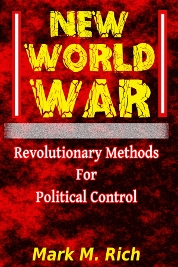Main Menu
Updates
-
Update: December 07, 2025
Not Encountering Others....more - Important Updates
- Previous Updates
- Attack Log
Donations
- I accept cryptocurrency & PayPal
Available Books
New World War: Revolutionary Methods for Political Control
Dedication & Thanks
Volume I: Current Political Situation
- Overview
- Introduction
- Revolution in Warfare
- The Other World
- Dictatorship Creation
- The Groups Facilitating the Revolution
- Their Goal is Neo-Feudalism
- Problem-Reaction-Solution
- Volume I Commentary
Volume II: The New War
- The New War
- The New Enemy
- Initiatives to Remove Civil Liberties
- The Investigation
- Surveillance Technology and Methods
- Mind-Reading
- Volume II Commentary
Volume III: Weapons of The New War
- Introduction to Nonlethal Weapons
- Psychological Operations
- Introduction to Directed-Energy Weapons
- High-Powered Microwaves
- High-Powered Lasers
- Sonic Weapons
- Computer Network Operations
- Microwave Hearing
- Silent Subliminals
- Use of Citizen Informants
- Chemical and Biological
- Weather Warfare
- Miscellaneous Weapons and Tactics
- Volume III Commentary
Volume IV: The Coverup
- Volume IV Introduction
- Schizophrenia Spectrum Disorders
- Control of the Medical Industry
- Another Look at Schizophrenia
- Political Considerations
- Punitive Psychiatry in Communist Russia
- Coverup Initiatives
- Volume IV Commentary
- Conclusion
Appendix
- A Brief History of PsyOp
- Small-Scale Wars
- Nongovernmental Organizations
- Human-Computer Intelligence Network
- Electronic Tyranny
- Other Devices Connected to the GIG
- My Experience
- Sources
Other Sites
The new weapons and tactics, which will be discussed here and expanded upon in Volume III, are part of a revolution in warfare. There are various definitions of what constitutes a revolution in warfare.
Some authors have assigned the labels such as a revolution in military affairs (RMA) or fourth generation warfare (4GW). Authors differ in their definitions of RMAs, the number of them that have occurred, and their relationship to society.
The basic theory is that throughout history warfare has developed mostly in an evolutionary manner. However, occasionally, ideas or inventions caused fast and drastic changes. These changes not only affected the application of military force, but changed the larger geopolitical arena to the advantage of those who mastered the technology.
There are two types of RMAs. The first kind is driven by technology and is what most people think of as an RMA. They are referred to more accurately as military technical revolutions (MTR). Some call them small revolutions. An MTR is the use of new technology on existing strategies of warfare. Examples of this include the invention of gunpowder, the airplane, the submarine, and the Intercontinental Ballistic Missile (ICBM).
Another type, which some suggest is a true RMA, includes an MTR, as well as changes in the organizational structure, strategy, ideology, and training of the military. This kind of RMA changes not just the way wars are fought, but is accompanied by profound changes in society, in areas such as diplomacy, politics, economy, business, etc. Some wars, which occurred during the industrial revolution, such as the Napoleonic Wars, are examples of this.
Warfare is said by some to have been revolutionized when Alexander the Great combined infantry and cavalry forces. Some say the Roman army’s use of arrows, staffs, shields, and precise formations against the more numerous barbarian hordes was an RMA.
The tactic of using a spear on horseback, invented in the 1500s, which joined the power of the horse with the thrust of the spear, is claimed by some to have been an RMA. The invention of gunpowder during the late Middle Ages, which replaced swords and bows, was another.
The German Blitzkrieg, which used radios in tanks and planes to coordinate them in a highly maneuverable way, was an RMA according to some.
RMAs linked to the industrial revolution include the Napoleonic Wars, which for the first time used the resources of the industrializing nations to equip mass armies, as well as the American Civil War, which used the railroad and telegraph to extend mobility, communications, and logistics.
The invention of ICBMs, which allowed for the destruction of massive sections of a country, affecting not just its military, but its economy, social, and political system, is considered by some to have been an RMA.
But the military revolutions we’re concerned with here are ones connected to massive societal changes. So to simplify matters, for the purpose of this study there have so far been two great military revolutions, both of which have been caused by larger societal changes.1 Military revolutions occur when changes are made in technology, strategy, organizational structure, training, ideology, tactics, and other areas of the military, as well as society itself.
Revolutions, generally speaking, occur when the entire structure of a society changes. This includes civil institutions, families, culture, value systems, and technology. This societal revolution causes an RMA. A true military revolution occurs only when an entire society is transformed at every level, which then compels the armed forces to undergo a massive change. This societal change causes the true military revolution, which results in a mostly simultaneous change in technology, organization, strategy, tactics, training, ideology, and logistics.2
This change in the military, which is caused by the larger societal change, transforms the relationships between the military, the economy, and society. This is a profound revolution that rarely happens. This has occurred only twice in history. The third one is now beginning.
Although military theorists differ in their beliefs regarding these RMAs, they all agree one is now taking place. It is the biggest in our planet’s history and will massively shift the geopolitical structure. According to official sources, it will result in the abolishment of the nation-state. Nonlethal weapons, including directed-energy weapons and psychological operations, are said to be at the center of this revolution.
To understand the larger context in which this RMA is occurring, the wave theory of global change promoted by futurists Alvin and Heidi Toffler will be instructive. Even if you don’t agree with their ideas, because of the influence of their work on world leaders and the accuracy of their predictions, it will be helpful to examine their basic theory.
Heidi has been an adjunct professor at the Institute for National Strategic Studies at the National Defense University in Washington D.C. She has multiple honorary doctorates and has served on the Advisory Board of the US Committee for the United Nations Development Fund for Women. Alvin has served as a visiting scholar at the Russell Sage Foundation, and visiting professor at Cornell University. He has multiple honorary degrees. He has served on the Advisory Council of the US Comptroller-General and is a member of the International Institute for Strategic Studies.
In the early 1980s Alvin’s book, The Third Wave, became the interest of generals in the US military who suggested it to high-ranking military personnel under their command. Their books, War and Anti-War, Powershift, and particularly, The Third Wave, have influenced presidents, prime ministers, business leaders, educators, psychologists, and social scientists. With great accuracy, they have been able to predict future trends in our society, in areas such as economics, social psychology, military affairs, politics, pop culture, religion, etc.
According to Alvin Toffler’s wave theory, there have been several revolutionary changes that have occurred globally. They include the agricultural revolution, the industrial revolution, and the current information/technological revolution. These waves of change have moved at different speeds.
When they occur, they cause turbulent forces that affect our planet in areas of work, family, economy, politics, ideologies, etc. In the case of the Third Wave, it is the end of industrialism and the rise of a new civilization. The disastrous forces that accompany these waves may appear to be unconnected, but are in fact part of the larger event.
Understanding these revolutionary waves is the secret to making sense of the conflicts spanning many areas which we see around us, says Toffler. When we understand the wave theory, most of these seemingly senseless and separate events reveal themselves as part of the same pattern, and things become comprehensible.
The First Wave occurred sometime around 8000 B.C. It began to lose momentum between 1650 and 1750 A.D., and almost came to a halt in the mid-1900s. First Wave civilizations were attached to the land. They were part of the agricultural revolution, regardless of their language, religion, or belief system.
Most soldiers were farmers who volunteered for combat but also needed to run their farms. Some of them were paid with land for their services. Prior to the First Wave, most people lived in small migratory groups and they fed themselves by hunting, foraging, fishing, and herding. Then, about 10 thousand years ago the agricultural revolution occurred and slowly moved across the planet offering a new way of life. This was the First Wave. It is almost finished. Only a few tribal populations remain to be influenced by agriculture.
Before the First Wave lost momentum, the industrial revolution started in Europe, which unleashed the Second Wave of planetary change. This Wave moved more rapidly than the first across continents. When it occurred, two distinct changes were taking place simultaneously at different speeds.
The Second Wave began somewhere in the range of 1650 to 1750 A.D. and produced an industrialized civilization which dominated the planet until it also lost momentum. It arrived at different speeds in industrialized nations such as Japan, Britain, France, Sweden, Germany, and the Soviet Union. In America it peaked during the 1950s.
Industrialism included assembly lines, factories, new social systems and family types, machinery, vehicles, appliances, mass media, mass production, mass destruction, public transportation, etc. Industrialism was a change in economic, political, and social systems, as well as a way of life. It gave rise to the nation-state and its related mentality. At this time, the Second Wave has already revolutionized Europe and North America in just a few centuries and it continues to spread. It has not yet been completed but has lost momentum.
The Third Wave began in the late 1970s. It is basically information, technology, electronics, education, training, and services. But mostly it is information and technology. The Third Wave is gaining momentum and will continue to occur over the course of many decades. Toffler says it is the equivalent of the technetronic age described in Zbigniew Brzezinski’s book, Between Two Ages: America’s Role in the Technetronic Era.
So, many countries are feeling the simultaneous impact of two or even three separate waves moving at different speeds with various forces behind them. Each time one of these massive global changes has happened there has been a collision of societies, or what some refer to as a clash of civilizations. This includes wars, rebellions, uprisings, overthrows, strikes, and political turmoil. When this occurs, one civilization relies on an older war-form than another.
It has been suggested that the industrialized North defeated the more agrarian South during the Civil War in the US because of this. A better example of this clash would be when the Meiji Revolution in 1868 caused the industrial revolution in Japan, during which time the Samurai were replaced by drafted soldiers. This included new weapons which were used during the 1877 Satsuma Rebellion when the Samurai made their last stand against the army of the Emperor.
The Emperor’s force included some Samurai as well as draftees armed with Gatling guns, mortars, and rifles. Here, one side relied on a single war-form while the other combined them. The colonial wars, which were waged during the 1800s and early 1900s, are another example. The Second Wave industrial elites of Europe, North America, and Japan fought First Wave agrarian civilizations in Africa, Asia, and elsewhere.
By conquering these lands the elites gained control over much of the planet. Cecil Rhodes, for instance, seized vast territories in South Africa from tribal groups. During these conflicts the forces of the industrial elites were equipped with machine guns while the tribal groups used edged weapons.
However, they were not successful in conquering these territories just because of the new technology, but because they were the result of a Second Wave society. They were also better trained, systematically organized, and had other advantages. They were fighting a Second Wave War while their adversaries were using a First Wave war-form. They represented a clash of civilizations, a different way of making wealth, and their militaries reflected that clash.
This occurred in almost every country undergoing industrialization. And, although these conflicts were seemingly unconnected, they were all part of the same global movement. The Second Wave is instructive to understanding the conflict now taking place. Because, according to Toffler, ideologies associated with the Second Wave are the primary obstacles to the creation of a new civilization.
Fundamental changes in the way the US wages warfare are now occurring which has intellectual, social, technological, ideological, organizational, and operational significance. A re-organization is happening in the military which is centered on the use of this technology.
It includes autonomous robots, tiny robots less than a millimeter in size, nanotechnology, the use of satellites, advanced forms of communication, self-producing intelligent sensors only a few nanometers in size, biotechnology, and nonlethal weapons.
It also consists of sophisticated remote sensors for surveillance, long-range precision strike weapons, advanced C4ISR systems, UAVs, and intelligence networks, as well as autonomous wide-range, high-speed collection devices capable of identifying specific targets and providing near-real-time information on an adversary. These intelligence systems are terrestrial, aerial, and space-based.
In this new type of warfare, small-scale battles will be common as governments find it more cost effective compared to large conventional forces. Small units armed with advanced weapons that offer precision strike capabilities at great distances will be used.
The DOD’s Quadrennial Defense Review Report of 2006 says that complex covert wars of long-duration will be waged by Special Forces units of the US military and its allies in multiple countries around the world simultaneously. These wars will include persistent surveillance on enemy personnel, global mobility, and rapid strike capabilities.
These small units, which some call 4GW Forces, act on mission orders to neutralize threats that exist among the civilian population. The Marine Corps Gazette described them as “small, highly mobile elements composed of very intelligent soldiers armed with high technology weapons” that “range over wide areas seeking critical targets.” These forces are allegedly equipped with advanced surveillance technology which has artificial intelligence. Their targets are mostly civilians.
In 1970 Zbigniew Brzezinski, co-founder of the Trilateral Commission, described that not only was a completely new arsenal of weapons under development, but the concepts of strategy were transforming. He said these new weapons included weather attacks, autonomous warships, chemical and biological weapons, and death rays. According to Brzezinski, this technology could be used for conducting “secret warfare” by a small number of security forces. Some of this technology, including directed-energy weapons, may be used by the US for assassinations under conditions which offer plausible deniability.
The Omega Research Foundation’s report to the European Parliament in September of 1998, An Appraisal of the Technologies of Political Control, observed that a revolution in military affairs was indeed occurring, and warned that the technology will be used by the security forces of various countries for suppressing internal dissent.
The British Society of Social Responsibility in Science (BSSR) issued a similar alert.3 The BSSR was founded in May of 1969 in response to the use of biological weapons by the US in Vietnam. In the mid 1970s they conducted research on emerging technology that could be used by the leaders of democratic governments to neutralize their internal enemies. This was described in their 1977 book, The Technology of Political Control.
The technology of political control includes the use of advanced scientific techniques and technology to neutralize a state’s internal enemies. This type of control is directed mostly at the civilian population. It is not intended to kill but to coerce. It includes advanced methods for monitoring dissent, and devices for controlling protests, as well as new weapons.
The BSSR observed that the history of these military revolutions consists of an uninterrupted process of a small group of ruling elites using new technology to destroy their opposition. This new technology, they predicted, was to be used by the military, the intelligence services, and the police, to isolate and neutralize people who were most likely to lead widespread political protest.
The technology was to be blended into the existing political conditions of liberal democratic nations. Although proponents of the technology would claim that it was more humane than conventional weapons, the underlying motives for its use were not humane.
Instead, it would be used to conceal the level of force being applied. And its use would be covered-up. According to the BSSR, a new group of military strategists, including high-ranking officers and civilian experts on defense subjects, would surface to promote the new technology. These experts would try to convince the public that the technology should be used to counter internal dissent.
To achieve this, the experts would write articles and give speeches on the subject, with the intention of accomplishing several goals. First, they would provide the technical information on how to deal with counterinsurgency. Also, they would influence the military command, the government, the media, and the civilian population to gain their support for this technology.
The writings of these new experts would contain omissions and distortions. The experts would also link actual existing threats with internal dissent to justify the use of the technology on civilians. By these efforts, the experts would prepare society for the use of the technology on civilians to suppress dissent.
Interestingly, in their influential article of July 1994, The Revolution in Military Affairs and Conflict Short of War, published by the US Army War College, Steven Metz and James Kievit mentioned that in the early 1990s there had indeed emerged an influential group of military strategists consisting of senior military and civilian leaders, which they described as “visionaries” who were promoting this technology.
Also, says Metz and Kievit, the public’s perception of this technology would need to be changed in order to remove significant constraints on its use. According to Metz and Kievit, the American people would not favor the use of the new technology unless they were led to believe that the nation was in danger. The promotional campaigns for this technology basically began in the early 1990s by the lobbying efforts of Janet Morris and John Alexander through the US Global Strategy Council (USGSC).
These individuals still continue to publish books and articles promoting it as part of a New World Order. Later studies in the mid to late 1990s would be conducted by the Council on Foreign Relations (CFR) to promote its use. Books by the Tofflers, the RAND Corporation, the National Research Council (NRC), and others continue these efforts.
Endnotes
1 In their book War and Anti-War Alvin and Heidi Toffler state that there have been only two major ones, with the third having just begun. The book In Athena's Camp: Preparing for Conflict in the Information Age, authored by David Ronfeldt and John Arquilla and published by the RAND Corporation, indicates there have been four so far, with a fifth underway. 4GW advocates also suggest that four have occurred, with a fifth emerging. See the book The Sling and the Stone: On War in the 21st Century, and the article Fourth Generation Warfare Evolves, Fifth Emerges, both by Colonel Thomas X. Hammes, USMC.
2 There are different schools of thought regarding whether these RMAs cause the larger societal changes or are caused by them.
3 Although the BSSR declared that these military theorists would originate in Britain, because they mentioned that the technology of political control was to be used globally, it is inferred that similar experts would emerge in other countries, such as the US. This certainly appears to be the case. They also mentioned that the RAND Corporation would be involved.






